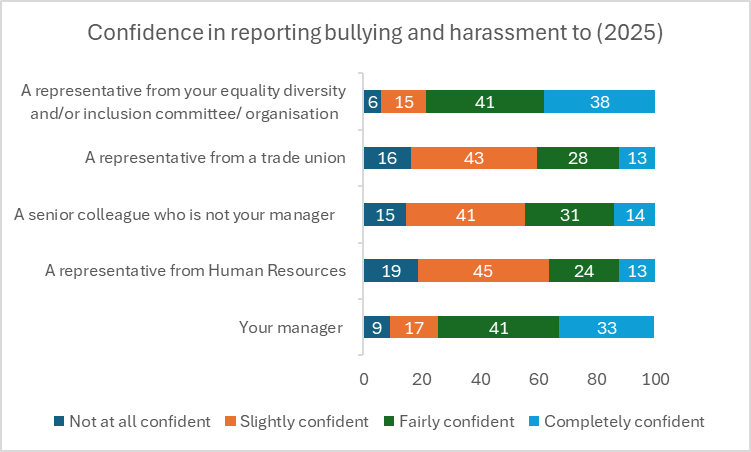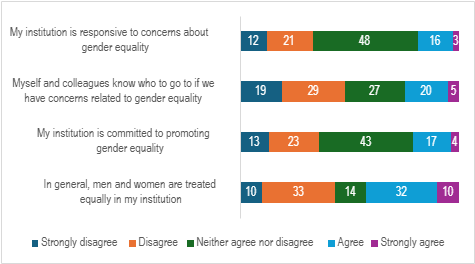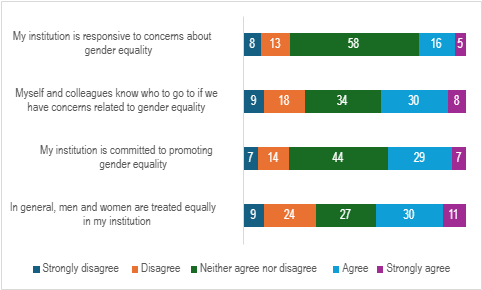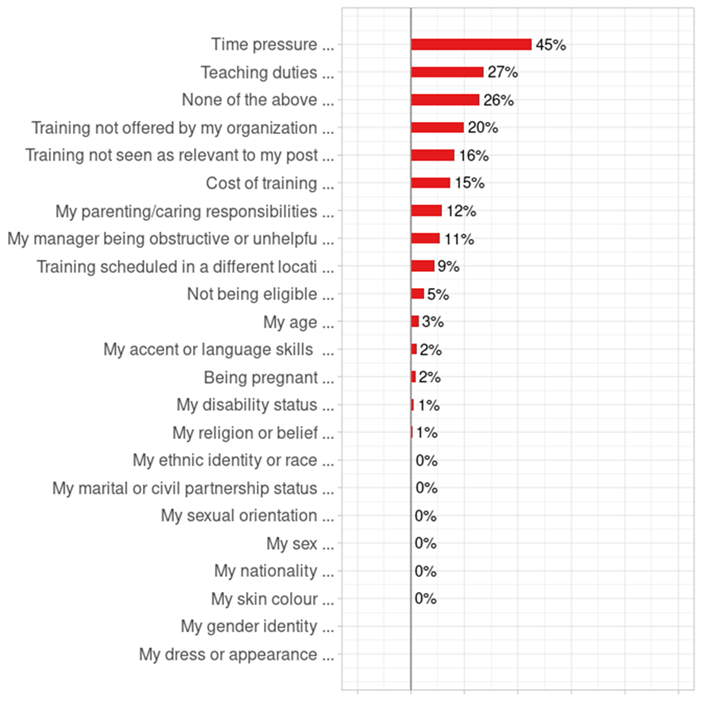7 Using GEAM data for GEP design or revision
This chapter explores how GEAM results can inform the design or revision of interventions within GEPs, highlighting key variables that have been instrumental in these processes. Most importantly, GEAM questionnaire gathers many variables that allow to verify and monitor the situation concerning the recommended areas of GEP interventions, such as 1. work-life balance and organisational culture, 2. gender balance in leadership and decision-making, 3. gender equality in recruitment and career progression and 4. measures against gender-based violence, including sexual harassment. We discuss the steps for the analysis of GEAM results from administration perspective, that would allow you to utilise GEAM results for the design of Gender equality plan.
Gender equality plans (GEP), gender policy, institutional change
Improving gender equality should be an ongoing process. Therefore, the monitoring and evaluation of the progress are an essential phase of a GEP lifecycle. In their GEPs organisations should detail not only the set of activities that are required to achieve the defined aims, but also specific indicators to measure the achievement of these aims. Relevant indicators should be developed, regularly verified and communicated in GEP progress reports (European Commission 2021). The GEAM tool can be used to verify some of these indicators, both quantitatively and qualitatively as it gathers feedback and inputs from staff and students on the organisational working culture, the perception and experiences of gender (in)equality in the organisation, organisational practices promoting gender equality, as well as sexist attitudes and behaviours. The GEAM questionnaire gathers many variables that allow to verify and monitor the situation concerning 1. work-life balance and organisational culture, 2. gender balance in leadership and decision-making, 3. gender equality in recruitment and career progression and 4. measures against gender-based violence, including sexual harassment. It does not cover the fifth recommended area of GEP intervention - inclusion of the sex/gender dimension into research and teaching content. However, the student and employee GEAM questionnaires can be adapted by adding a few questions or items to the existing questions tailored to the organisational needs – or to monitor specific action in the GEP.
GEAM results can be an appropriate complement to the existing sex-disaggregated administrative data and qualitative data, e. g. from individual or group interviews. Thus, the use of the GEAM survey in an organisation facilitates the fulfilment of the Horizon Europe GEP minimum mandatory process-related requirement to regularly collect, analyse and report sex-disaggregated data on personnel. With the module on “Training”, the survey also allows to verify the intake among the members of the organisational community of awareness-raising and training activities on gender equality and unconscious gender biases, which also need to be organised according to EU requirements.
In what follows, we present the coverage of the GEAM survey and the support that this manual can offer you in elaborating specific topics of GEP. In the following chapter, we present the possible timeline of activities from a perspective of an administrative employee. The chapter concludes with an example of an institutional analysis in the perspective of GEP development – we show how the GEAM data can be used for the monitoring of progress and improvement of further GEP editions.
Recommended thematic GEP building blocks
Considering the mandatory GEP process-related requirements GEAM directly answers to the requirement of data collection and monitoring – providing additional data to monitor GEP implementation with selected indicators. It also covers the topic of training participation in regard to specific topics of the training and allows to monitor the barriers in participation. Considering recommended areas, GEAM covers 4 out of 5 of them, leaving out the area of “Integration of the gender dimension into research and teaching content”. All other areas are well covered in indicated GEAM sections (see table 1).
| GEP eligibility criterion | Coverage in GEAM sections | GEAM Manual |
| MANDATORY | ||
| Publication and official endorsement of the GEP | Questions evaluating organization’s commitment to gender equality (OCPER001) | Chapter 8 |
| GEP has dedicated resources | Not included | |
| Data collection and monitoring | GEAM as a tool for data collection and monitoring of GEP outcomes and impact | |
| Training | Working conditions – Training (included: Unconscious bias, equality - diversity - includsion training; Sexual and/or sexist or gender harassment) | |
| RECOMMENDED | ||
| Work-life balance and organisational culture | Working Conditions - Work-life balance; Working Conditions - Flexible working time and teleworking arrangements, training Working Conditions - Caring Responsibilities, Working Conditions - Parental Leave, Organisational Culture and Climate - Working Culture, Organisational Culture and Climate - Gender Equality |
Chapter 3, Chapter 4, Chapter 7, Chapter 8 |
| Gender balance in leadership and decision-making | Working conditions - About your current job; Organisational Culture and Climate - Working Culture | Chapter 2 Appendix A |
| Gender equality in recruitment and career progression | Working conditions - About your current job, Working Conditions - Recruitment and Promotion, Working Conditions - Training | Chapter 3 |
| Integration of the gender dimension into research and teaching content | Not covered | |
| Measures against gender-based violence including sexual harassment | Behavior - Bullying, Harassment, Microagressions (with the use of selected questions from UniSafe questionnaire on gender-based violence) | Chapter 4, Chapter 5 |
7.1 Steps for the analysis of GEAM results from administration perspective
In this chapter we describe steps from the moment GEAM survey had been conducted. If you need guidance for setting up and launching a GEAM survey, please consult the GEAM Manual. In what follows we provide suggestions on how to best use the GEAM results for the design and implementation of GEP, as well as its’ monitoring and evaluation. The instructions are written from a perspective of a person working in a role of coordinating GEP or gender equality policies/programmes.
7.1.1 Analysis of GEAM data and publication of results
1. First general report. The overview of all the answers to the survey is a basis for targeting the most important issues that appear in your data. As soon as the data collection is completed, your institution should generate a complete report with main results of the survey, containing simple frequencies and crosstabulations illustrating how answers to questions differ by gender or position at the university. Such report can be automatically generated using the GEAM reporting template, thus it does not demand any resources from your department nor expertise in statistics on your side. Nonetheless, it is a good practice to involve researchers from your institution who would support you in data analysis and preparing a publication of the basic results, as well as support you in more in-depth analysis further on.
2. Publication of results. Having the results analysed, plan publication of data in a form of report or public presentation showing main results of the survey. As GEAM survey is quite extensive, you may plan more than one report/presentation. One main report should provide overall results of the survey and indicating main trends, others could offer more in-depth analysis of the selected topics. Note: The publication of the data on GEP monitoring and making it publicly available is a condition from European Commission in regard to eligibility criterion.
3. In-depth analysis of selected topics. General analysis would allow you to select 2-3 most important topics from the perspective of your institution. The topics may stem from the data that you have obtained and by the results that call for change, or from the internal debates in the institution for which GEAM data may be an important source. A good advice is to focus on variables/areas with significant gender disparities (or disparities that are based on other traits that characterise employees e.g. position, age, or engagement in care). Be aware of paying too much attention to the size of the phenomenon – in some cases even little occurrence may be a calling for intervention, in other cases – the underreporting may be an issue (e.g. in case of violence). Depending on the topic, you may involve specific groups already in the data interpretation (see below, p. 1 in involving stakeholders in designing of interventions). Other chapters of this manual may help you to analyse the results in regard to different topics (see table 1). Also, if you are planning to design inclusive gender equality plan, consider other variables for analysis. See for exampole Ciaputa et al. (2024) on how to conduct gender+ audit.
4. Monitoring change. For judging e.g., the effectiveness of some policies the time perspective might be needed, and you might be able to pinpoint important topics only after two waves of the survey. An example of such analysis is available in Chapter 4.
7.1.2 Planning interventions on the basis of GEAM data
Here we demonstrate how to use the GEAM results for the design of GEP interventions. This relates to the GEAR tool Step 3: Setting up a Gender Equality Plan. When defining strategic goals for the GEP (e.g. increase women in leadership, make organisation more friendly for parents), not only keep in mind the GEAM results, but also consider other types of data as well as external GEP requirements (e.g. Horizon Europe GEP eligibility criterion, Table 1) and available resources.
1. Involving stakeholders. Once you identified problems to be addressed in the GEP, involve different stakeholders in the process of designing and planning particular interventions. Start with identifying relevant stakeholder categories (e.g. HR personnel, middle management, early career women researchers, employees with special needs, faculty staff of specific faculties, students with caring responsibilities, etc.) and invite their representatives for consultations on the GEAM results. Through group or individual discussions, workshops or interviews engage them in the design of the potential forms of intervention. To ensure diverse stakeholders’ sustainable involvement in the process engage them in existing structures of GEP implementation or create new formal or informal structures (committees, working groups on specific areas of intervention). Ensure (active) involvement of people in senior management positions in deciding on the areas of intervention to be addressed to assure strategic support. When advocating for their engagement, use the GEAM results in highlighting the current issues and employees’ opinions.
2. Designing interventions. Within a participatory process, design specific interventions for each strategic goal identified through the analysis of the GEAM results. When deciding on specific measures, consider their attainability within a given context and timeframe. Make sure they are measurable, and their effects are possible to be assessed, e.g. with administrative data or GEAM results. For each measure, agree on and assign meaningful indicators, responsibilities, timelines and resources needed for their implementation. Ensure (active) involvement of people in senior management positions in deciding on the final list of measures to be implemented within a GEP.
3. Plan future monitoring. When designing interventions consider their potential effects and select indicators from the GEAM survey that in the future may serve useful in judging its outcomes and implementation. For some interventions, you might need additional indicators to be added to GEAM edition run in your institution – remember that GEAM is flexible and adding or cutting a question is not a problem.
7.1.3 GEAM as a monitoring and evaluation tool
After implementing the GEP, re-run the GEAM survey periodically (e.g., every 2–3 years) to track progress and adjust priorities as the situation evolves. To evaluate how GEP actions are perceived and adopted you can also use administrative data and the results of interviews with various organisational stakeholders. Engage members of working groups/committees to reflect on the progress and challenges. Based on the monitoring results, including GEAM, and the reflexive process, update the GEP. When reporting the implementation of the GEP to both internal and external stakeholders, use GEAM results to illustrate the progress and the need for further consideration.
7.1.3.1 Example I - Comparing perceptions in time
The following example demonstrates how GEAM results can inform activities within the GEP in an exemplary higher education institution. In this institution the survey was run in 2020 and then in 2025.
The results of GEAM survey conducted in 2020 revealed that about half of the employees was missing confidence in reporting bullying and harassment to a representative of trade union, human resources, or other senior colleagues. Since then, GEP had been implemented (in 2022), existing structures for gender equality had been developed: new bodies and positions had been appointed and information campaigns about those developments had been launched. The results of the GEAM survey 2025 suggest that these measures were legitimate and moderately effective in a short run: visibly more employees than in 2020 declared confidence in where to report concerns related to gender equality and noticed institutional efforts to promote gender equality. Less proportions of the survey participants would not report bullying and harassment to any of the listed positions. The most trusted to report to are on one hand, equality office/committee, or on the other hand – one’s manager.


Similarly, the answers to the question “Myself and my colleagues know who to go to if we have concern related to gender equality” show that much higher percentage of respondents know where to direct such concerns to. In 2020,almost half (48%) did not know where to go to in such case, comparing to 27% of respondents in 2025.
At the same time, however, the shares of employees perceiving deeper, more sustainable effects of the implemented activities (such as ensuring effective equal treatment) did not increase substantially and remained at an unsatisfactory level. In 2020, 42% of respondents agreed that men and women are treated equally in the institution and 43% disagreed with this statement. To compare, in 2025 the numbers were respectively – 41% and 33%. We observe the increase of answers ‘Neither agree nor disagree’, but not in the percentage of those who agree with this statement. Still, the negative responses were more frequent.
When it comes to responsiveness of the institution to concerns about gender equality, while in 2020, 33% of respondents believed that the institution is not responsive to concerns about gender equality, in 2025 this number dropped to 21% – suggesting less critical opinions on institution’s responsiveness.

Still, in both editions, about half of respondents choose the middle category (‘Neither agree nor disagree’), and percentage of those with positive opinions remained unchanged. Similar distribution of opinions can be observed in the question on institution’s commitment to promoting gender equality.

Concluding, these results imply the necessity for implementing specific measures targeted at setting clear pathways for reporting unequal treatment, reliability and transparency in considering cases of unequal treatment, bullying and harassment and addressing organisational culture. The answers indicated that undertaken actions regarding setting up relevant structures directly assigned to deal with the matter of gender equality and equal treatment have had some positive effects, but more interventions are needed to promote what the institution is doing regarding GEP implementation. There is a need to reflect to which groups the activities are directed and if all departments of the university are equally informed and targeted by its actions and relevant communication. Better communication on the activities regarding gender equality and GEP implementation are necessary for raising awareness of institution’s engagement. Some activities in further engaging employees in activities related to GEP would be also recommended.
7.1.3.2 Example II - Monitoring training activities
The second example relates to the data that was gathered at one point of time. We use the example from the section on training participation. Within GEP eligibility criterion, “a GEP must include awareness-raising and training activities on gender equality for the whole organisation and training on unconscious gender biases for staff and decision-makers” (European Institute for Gender Equality 2016). Beyond this requirement, pparticipation in trainings is an important aspect of career progression as it allows to develop and enhance the skills, knowledge, and competencies needed to advance in a career. It might be the case that the access to trainings is hindered for certain categories of employees in a given organisation (Kroese 2022), which would need to be addressed with tailored measures.
The GEAM includes a separate module devoted to training opportunities. It consists of three questions on receiving trainings and barriers to accessing them.
| Code | Question / Answer options | Responses |
|---|---|---|
WCJC019 |
We are interested in the training opportunities available to you. Please indicate which, if any, of the following you have received training in. | [1] not-checked [2] checked |
.SQ001 |
Administrative tasks related to managing other members of staff (e.g. conducting annual performance reviews, induction processes for new staff) | |
.SQ002 |
Leadership development (e.g. preparation for senior managerial appointments) | |
.SQ003 |
Professional development | |
.SQ004 |
Grant or funding application skills | |
.SQ005 |
Teaching and/or student supervision | |
.SQ006 |
Project management training (e.g. leading project administration, budgets, etc.) | |
.SQ007 |
Unconscious bias, equality, diversity, and inclusion training | |
.SQ008 |
Bullying/harassment at work | |
.SQ009 |
Sexual and/or sexist or gender harassment | |
.SQ010 |
Accounting or financial management accreditation programmes | |
.SQ011 |
IT courses (e.g., training related to using specific software programs, website design, etc.) | |
.SQ012 |
Job shadowing or placements (e.g. within another department or faculty to develop skills required for progression) | |
.SQ013 |
Human Resources (HR) courses or accreditation programs | |
.SQ014 |
Course on legal regulations / changes | |
.SQ015 |
None of the above |

As Figure 7.1 for the WCJC019 demonstrates almost ¼ of the respondents did not participate in any of the trainings, which may signal the existence of barriers to accessing training or poor fit of the training offer to employees’ needs. In both cases there is room for improvement through dedicated actions within a GEP or any other equality policy. As was mentioned above, the question on training opportunities allows to capture the participation in gender equality trainings, which are an important GEP activity. Among various themes of training included in the WCJC019 that a respondent can report participation in, there are “unconscious bias, equality, diversity and inclusion” and “sexual and sexist or gender harassment”. As the bar chart above demonstrates, only 5% of respondents participated in unconscious bias training, which suggests the need to better address this issue in the next cycle of GEP implementation, with potentially more trainings available or targeting some groups of employees with obligatory training.
Next, we focus on question WCJC021 that asks about barriers to training opportunties.
| Code | Question / Answer options | Responses |
|---|---|---|
WCJC021 |
In the last 12 months, do you feel that any of the following have been a barrier to you accessing training that you needed or wanted? | [1] not-checked [2] checked |
.SQ001 |
Time pressure | |
.SQ002 |
Teaching duties | |
.SQ003 |
Cost of training | |
.SQ004 |
Not being eligible | |
.SQ005 |
A long term health condition or disability | |
.SQ006 |
Training not offered by my organization | |
.SQ007 |
Training scheduled in a different location | |
.SQ008 |
My parenting/caring responsibilities | |
.SQ009 |
My language skills | |
.SQ010 |
My manager being obstructive or unhelpful | |
.SQ011 |
None of the above |

Note that Figure 7.2 includes additional answer options regarding socio-demographic barriers to training (e.g. disability, religion, etc.). The standard/default configuration of the GEAM gathers information on multiple socio-demographic categories (see Chapter 2). This information can be crossed with any other question, including training barriers, to detect gaps for example on teaching duties being a stronger barrier for women compared to men (see also Chapter 3).
As Figure 7.2 demonstrates, only ¼ of the respondents did not encounter any of the listed barriers for accessing training. The rest of them recognised some barriers, often indicating the simultaneous impact of several of them (the answers do not add up to 100% as respondents could choose more than one obstacle). Time pressure was the single, most often reported barrier to training, followed by teaching duties. The responses received for the open question WCJC022 (If you indicated that any of the above were a barrier to obtaining training, please take a moment to explain why or how below) strengthen the issue of the employees’ overwork and difficulty in balancing work and private life, as the following quote demonstrates:
“The high volume of duties creates a strain on work that has to be done anyway, and going to training later makes it necessary to stay longer at work, and these hours are not paid extra. Staying after hours interferes with duties undertaken outside of work.”
The example indicates beyond overwork also institutional barriers to accessing training (e.g. distant locations, lack of access to training, for training not seen as relevant for a particular post) or financial ones (cost of the training). Also, even if not a very frequent (2%), language of the training is seen as an obstacle – considering e.g. English as a language for training may raise its accessibility. The combined results of WCJC021 and WCJC021 – analysed along gender and other socio-demographics - give insights into gaps in the training access and inform activities aimed at strengthening equality in career progression. Also, answers to the open question about barriers to training give insight into the issue and may allow to design better interventions.